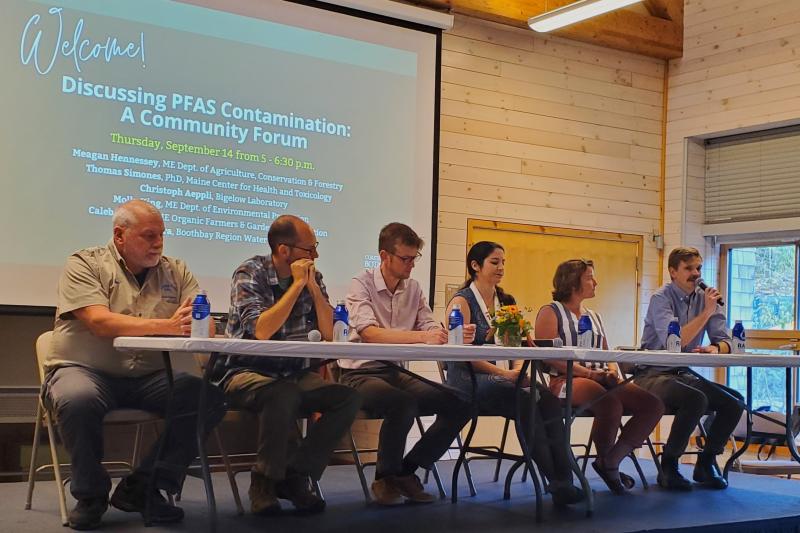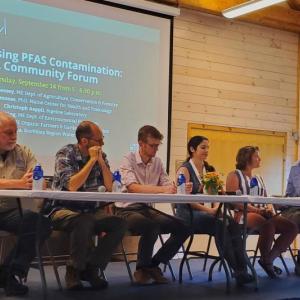Garden gathers expert panel to discuss ‘forever chemicals’
Experts from around the state came to Coastal Maine Botanical Gardens Sept. 14 to discuss a complex group of chemicals known as PFAS. These potentially harmful “forever chemicals” have been the focus of much research in Maine, but experts say the issue is a societal problem that is much larger than one state.
President Gretchen Ostherr said she wanted to host the event because tests revealed PFAS in the Gardens’ well water earlier this year. She said conditions are currently safe but she is still unsure about the cause, which is a common story.
“It made me realize that there is a lot we don’t know about PFAS and there are people in the state who are working to learn more about it,” she said. “Maine is on the cutting edge.”
PFAS are synthetic chemicals used in everyday products including fabrics, cleaners, fire-fighting foam and food processing equipment. They were developed in the 1930s, widely used in the 1950, but are no longer produced in the U.S., according to members of the panel. There are almost 15,000 individual PFAS chemicals, according to the Environmental Protection Agency.
The health risks of PFAS are not fully understood, but the EPA says scientific studies have shown exposure may be linked to harmful health effects including reproductive issues, elevated risk of cancer and weakening of the immune system. Experts on the panel clarified that PFAS exposure or detection does not guarantee negative health impacts.
Thomas Simones with the Maine Center for Disease Control and Prevention is part of work with the state to set action levels for how much PFAS is too much in foods such as milk, beef and even backyard chicken eggs.
He said one of the largest concerns is their persistence, which is why they are called “forever chemicals.” Because of their chemistry, the compounds do not break down easily, and can remain in the environment for a very long time. Simones and his colleagues are still working on understanding how PFAS chemicals travel.
“This is a unique class of chemicals that is very persistent, and it moves in unique ways …," said Simones.
According to experts on the panel, PFAS is ubiquitous in the environment, our homes and bodies; It has even been found in Antarctica. Panelist Jon Ziegra, from the Boothbay Water District, said the Boothbay Region is not immune, and there is PFAS in local water sources, but below current regulatory thresholds.
Sludge from waste systems has perhaps been the most notable source of PFAS. As homes use products with PFAS, or humans expel it from our bodies, the chemicals get in water and waste systems. Waste sludge has been used since the 1970s as a benefit in farms to add nutrients to the soil, which has led to potential land and food contamination, according to panelist Molly King with the Maine Department of Environmental Protection. She said the practice was banned in 2022.
King is part of the state’s work to determine the determine the extent of PFAS contamination in Maine, slow work that often involves digging through paper records and other historical files. She said the state has completed 110 site investigations in two years with a goal to investigate over 1,000 sites. So far, 400 water supplies have been affected and are going through a mitigation process, she said.
“... (We’re) trying to get a handle on where it is,” King said. “It sounds goofy, but that’s what we are trying to do: Figure out where PFAS is in the state so we can wrap our heads around it and figure out what to do with it.”
Scientists are also researching how PFAS can impact the ocean. Christoph Aeppli with Bigelow Laboratory said PFAS are not only persistent but mobile in waterways. He talked about his research to learn the extent of PFAS in marine environments, how much PFAS is getting into organisms and how scientists can improve the tools used to detect it.
Meagan Hennessey from the Maine Department of Agriculture said discovering PFAS does not mean the end of farming at that location, but it requires financial support. She said a $60 million state PFAS fund helps provide support to farmers going through the process of remediating their land including crafting specific mitigation strategies for their site and products.
However, the cost is not just financial. Caleb Goossen with the Maine Organic Farmers and Gardiners Association said that most people have PFAS in their bodies, but some of the farmers he has worked with have some of the highest levels in the country. Hennessey said it is difficult to work with farmers who have had high levels of PFAS and grown food that feeds their communities and families.
“I’m fortunate that we have funding to support them for their business,” Hennessey said. “But I can't fix the exposure that they have had and the stress that puts on their family and the mental toll that it takes on them.”
However, moderator Gary Fish, the Maine State Horticulturist, urged people to be cautious about placing blame; PFAS have been used so widely in such a diverse range of products, it is hard to identify a source.
“We demand certain products, and companies fill those voids. When they do that sometimes they make things that aren’t exactly what we want them to be,” he said. “We are all part of the problem. Everybody here is to blame, not just the companies that make the products.”
The Gardens hosted the forum with Bigelow Laboratory for Ocean Sciences and the Boothbay Region Clean Drinking Water Initiative.

























